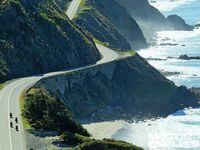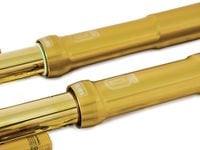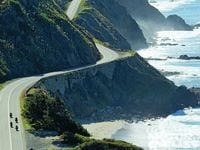Got A Question For Answers? Send It To mcmail@sorc.com
Gold Standard?
Why are so many new bikes coming with gold-colored forks?Honda's 2011 CB1000R looks really sweetexcept for that. Why not silver or black or chrome? If gold looks so cool, why haven't the manufacturers started making gold-colored exhausts? Maybe manufacturers are trying to imitate the world-famous suspension leader Öhlins?
Phillip Meier
Jamesburg, NJ
Imitation is the sincerest form of flattery. The most plausible motivation for any manufacturer to use that color is the hope that some of Öhlins’ solid-gold reputation will rub off on their bikes. According to Bengt Ohlsson of Öhlins USA, the original motivation was mostly pragmatic, as the Swedish company’s motocross shocks used to be painted brown. "When we went from steel to aluminum reservoirs, they were anodized instead," Ohlsson says. "When we discovered we couldn’t anodize them in brown, we went to gold." That imitation also explains the current popularity of yellow shock springs, another Öhlins hallmark.
Thin Skins
After digging out from the worst winter I can remember, I'm only finally getting around to rolling my 1999 Kawasaki Concours out onto snow-free pavement for the first time in months. The current set of Dunlop tires—K701 front, K700 rear—looks a bit worked after 12,000 miles or so, but I don't see any wear bars. Times are tight, so I've been thinking about trying to get another 2000 to 3000 miles out of 'em before laying out $220 or so for a new set. I'm cheap, not crazy. What would you guys do?
Ronald Caron
Chicago, IL
Spend the money. A motorcycle on worn tires doesn’t handle nearly as well as it would with a fresh set. That goes double on rainy days. Shallower tread grooves deliver sketchy handling long before those wear bars show up. Old, thin skins are much more susceptible to punctures as well. At best, a flat will ruin your day. At worst... we’d rather not think about it. For our money, the peace of mind alone is worth a whole lot more than $220.
Safety In Numbers
I have never been part of a group ride, unless two guys who don't stay very close to each other on the road are considered a group. I prefer to set my own schedule and consider riding an individual activity. I also see the attraction of a group ride—shared experience and all that—though it makes for very long toilet breaks.
I have read about safety gained from riding in a staggered formation, but can’t find any hard information on the safety of riding in a group vs. riding solo. The group has a number of negative aspects to it. With a 30-bike group riding in classic staggered formation at 60 mphgroups seem to ride under the national limit1.5 seconds of separation puts 132 feet between bikes. At that rate, a nominal 30-bike fleet would be about 4000 feet long. On a single-lane highway with limited opportunities for passing, or on a Southern California freeway, this behemoth is akin to a 4000-foot-long tractor-trailera rolling roadblock.
Have there been any studies on the overall traffic safety of this type of formation? Can you point us to some hard evidence showing the safety of group riding? The only other formation riding and driving I see regularly is for funerals and visiting heads of state, which usually have traffic-control assistance.
Mike Capoccia
Huntington Beach, CA
_Our research didn’t turn up any hard numbers on group riding safety either. Most of the Motorcycle Safety Foundation’s data comes from law-enforcement agencies such as the California Highway Patrol, whose accident information doesn’t specify whether a given rider was alone or not. We know this much: The bigger the group, the more dangerous it can be. That staggered formation has saved us more than once by giving individual riders room to maneuver. Better still, break one big group down into smaller ones of 4-6 riders.
Your hypothetical 30-bike convoy is a recipe for disaster unless everyone in it is comfortable with that many bikes and knows what to do when. That includes disbanding and regrouping when necessary. There's a lot to learn, but downloading the MSF guide to group riding www.msf-usa.org/downloads/group_ride.pdf is an excellent start. If you're involved in an event that involves a big ride, spend $35 on the MSF Group Riding Kit. The information therein could save youand your friends._
FAQ
Deer, Sir
After surviving a few close calls, I'm looking for the best way to keep from hitting some big, wild critter on the road. There are loads of yellow signs with flying deer on the roads we ride. A couple of my friends have wind-powered deer whistles on their bikes. Do those things actually work?
The best way to avoid painful contact with a deer is to be smarter than the deer. Take a lesson from deer hunters: They go looking for big, ruminant mammals in the couple of hours on either side of sunrise and sunset. If you are out riding in that timeframe, pay attention to those warning signs and slow down, especially around open areas close to the road. That goes double when they’re mating and migrating in late fall and early winter. If Bambi or one of his friends does cross your path, slow down and keep your distance until he scampers away. One deer on the road usually means more in the bushes, so back it down another notch. High beams can provide a little early warning; watch for the eyes. As for deer whistles, they’re more likely to make you less cautious than to have any actual effect on deterring deer.















/cloudfront-us-east-1.images.arcpublishing.com/octane/ITNLTIU5QZARHO733XP4EBTNVE.jpg)
/cloudfront-us-east-1.images.arcpublishing.com/octane/VZZXJQ6U3FESFPZCBVXKFSUG4A.jpg)
/cloudfront-us-east-1.images.arcpublishing.com/octane/QCZEPHQAMRHZPLHTDJBIJVWL3M.jpg)
/cloudfront-us-east-1.images.arcpublishing.com/octane/HXOUJXQWA5HBHGRO3EMJIGFMVI.jpg)

/cloudfront-us-east-1.images.arcpublishing.com/octane/3TIWWRV4JBBOLDVGRYECVVTA7Y.jpg)
/cloudfront-us-east-1.images.arcpublishing.com/octane/KIX5O23D5NAIBGFXBN3327DKZU.jpg)
/cloudfront-us-east-1.images.arcpublishing.com/octane/7GJYDUIPXRGMTMQKN6ONYOLBOU.jpg)
/cloudfront-us-east-1.images.arcpublishing.com/octane/MUQLOVLL2ZDGFH25ILABNBXKTI.jpg)
/cloudfront-us-east-1.images.arcpublishing.com/octane/TNOU5DNE2BC57MFPMGN2EIDXAM.jpg)
/cloudfront-us-east-1.images.arcpublishing.com/octane/GTCXACQGJ5HAPDTGWUQKDEH44E.jpg)
/cloudfront-us-east-1.images.arcpublishing.com/octane/S35YGSEMEZB4BLTDJTSZPF4GLA.jpg)
/cloudfront-us-east-1.images.arcpublishing.com/octane/5UOT6HPX2JFMRJAX6EH45AR4MQ.jpg)
/cloudfront-us-east-1.images.arcpublishing.com/octane/OKWOJWAKP5EP3OACCRRWPCIX2Q.jpg)
/cloudfront-us-east-1.images.arcpublishing.com/octane/2WF3SCE3NFBQXLDNJM7KMXA45E.jpg)
/cloudfront-us-east-1.images.arcpublishing.com/octane/G4MG6OUCJNBSHIS2MVVOTPX65E.jpg)
/cloudfront-us-east-1.images.arcpublishing.com/octane/IIGGWFOTOJGB7DB6DGBXCCMTDY.jpg)
/cloudfront-us-east-1.images.arcpublishing.com/octane/QSTCM6AVEZA5JJBUXNIQ3DSOF4.jpg)
/cloudfront-us-east-1.images.arcpublishing.com/octane/U4I7G625B5DMLF2DVIJDFZVV6M.jpg)
/cloudfront-us-east-1.images.arcpublishing.com/octane/B6XD6LS6IVCQPIU6HXDJSM3FHY.jpg)
/cloudfront-us-east-1.images.arcpublishing.com/octane/ICL63FEDDRDTTMINYICCEYGMDA.jpg)
/cloudfront-us-east-1.images.arcpublishing.com/octane/FCGZHQXRBZFLBAPC5SDIQLVF4I.jpg)
/cloudfront-us-east-1.images.arcpublishing.com/octane/WNOB6LDOIFFHJKPSVIWDYUGOPM.jpg)
